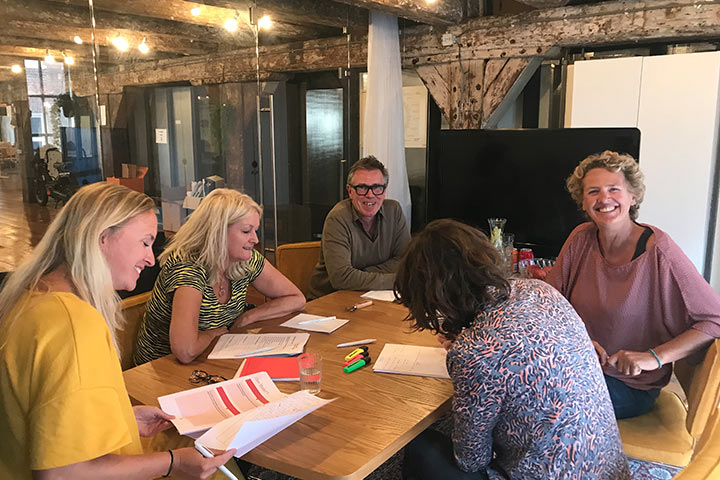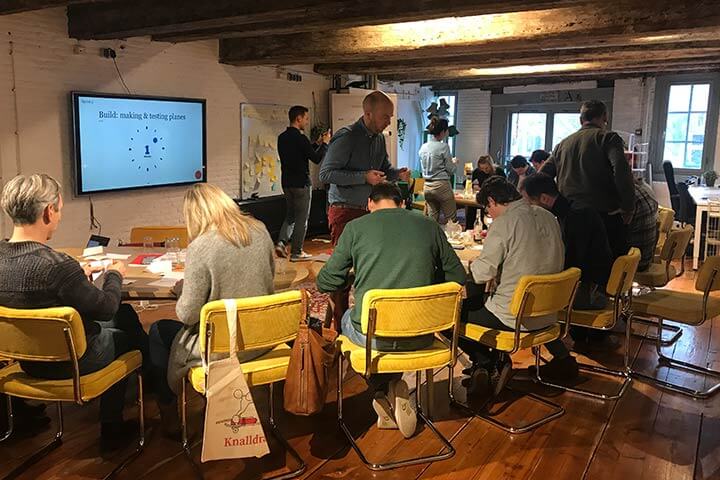This blog post touches upon the organisational habits that boost innovation and growth. Why are some companies more innovative than others? I want to argue that they have habits in place that produce more ideas and habits to get those ideas shipped. As Steve Jobs once famously said (paraphrasing William Gibson) : “Real artists ship”. In this blogpost I want to explore this innovation habit, based on our 8 year experience with collaborating with teams.
 The habits that kill innovation.
The habits that kill innovation.
Dozens of books have been written about this subject, but from our own experiences on running behavioural design sprints, these were the most common habits that kill innovation:
The bigger a company gets, the more out of touch it becomes with how real users think, feel and behave. Managers rely on abstract data, like market shares, sales volumes, etc. The more detached they become from the real customer, the less probable they will spot exciting opportunities.
Once an organisation outgrew its startup phase and entered its scale-up phase, the whole mindset of the organisation is focused on growing the business. Most businesses organise their process around building the existing product offering. Moreover, to achieve this growth mindset, a specialisation of roles is required. Everyone is expected to perform in their specific domain, from the product manager to marketing manager, digital manager, UX-er, and communication manager. This results in a decreased capability of the organisation to think out-of-the-box and to think outside-in. Nearly always, the exciting opportunity for innovation transcends the boundaries of the specific discipline.
The more an organisation specialises, the more we expect those specialists to know what they are doing. This expert fallacy is a well-known organisational problem: Because we are expected to be experts, we are more inclined to act like experts. The more we think we know, the less alienated we become from discovering the truth. Not knowing is perceived as a weakness in these companies, while every successful startup knows that aggressive experimentation is one secret ingredient to growth.
In most organisations, the problem with innovation is that everyone, including management, is hired to execute the strategy. Not only are they hired, but they’re also reviewed based on the execution of the strategy. When your promotion depends on hitting the targets, everything related to new ideas will be perceived as a distraction.
The net effect of these habits is total inertia.
Would you like to power up your team or project with behavioural intelligence?
Feel free to contact us. We are happy to tell you more about our consultancy or academy. Helping you innovate, transform or grow levering insights from behavioural science in practice.
The habits that boost innovation.
Innovation is not a goal as such. Innovation is always a function of growth. Some organisations are far better than others to spot opportunities, come up with ideas, test them and succeed in actually shipping them. Whether they improve the product, marketing, process or campaign, the value of new ideas is that they succeed in contributing to growth.That’s why we need to study the innovative power of an organisation as a habit problem.
Innovative companies have habits in place that trigger more curiosity, ideation, and experimentation. Continuous improvement is their default mode.
We have facilitated sprints with many teams. Most of them don’t call themselves “innovation teams”. They’re product teams, or growth teams, or customer experience teams. The biggest challenge they all face is to improve their output to generate growth for the business. There are four team habits we came across that strongly correlated with the creative and innovative power of a team:
Innovative teams have proper ideation sessions. They follow the core principles for group creativity (like brainwriting and dotmocracy) and treat every idea as an interesting hypothesis. In a well designed creative process, the individuals come up with as many ideas as possible and the group decides upon which ideas are worth experimenting.
Great teams have a maker-mentality. They always try to figure out ways to prototype their ideas and test them in the real world. This allows them to increase their learning curve and their success rate rapidly. An essential condition for allowing this to happen is to have an infrastructure that allows experimentation.
This is by far the most important habit. Very often, the problem is cultural. If the organisation is number-driven, then you’ll always end up with all kinds of triggers that incline people to believe that following the rules and reaching targets is what the organisation expects of them. However, if you want to create a culture of experimentation, then you’ll have to embrace failure, promote and rewards braveness. People need to experience that experimentation is being expected of them.
Incremental versus radical innovation
In the literature on innovation, quite often the distinction is made between radical and incremental innovation. Incremental innovation is the optimisation of the existing products and services, whereas disruptive innovation is the more radical ideas to transform the business.
To be honest: I think this distinction is a bit artificial. If you think about the innovation habits we described above, then they are about being radically customer-centred, about having a maker-mentality, and a culture of experimentation. Out of this habit, both incremental, as well as radical ideas can emerge. The only thing an organisation needs to have in place is a fund to invest in the rapid prototyping and testing of some of the more radical ideas.
What this means for innovation leadership.
When approaching the problem of innovation in organisations from this perspective, I think
The role of an innovation leader in a company should be to help to build the innovation habit.
I don’t believe an innovation department – as the place where innovation is happening -is the solution. An innovation leader / or innovation tribe should be a group of people that facilitate and train teams to install the innovation habit. If new radical ideas come out of this process, they should be able to invest money in them to be able to hire a team to design, build, prototype and test the idea in the real world. If this experiment turned out to be successful, then it’s their job to convince the board to invest in the concept with ambition.
BONUS: free ebook 'How to Convince Someone who Believes the Exact Opposite?'
Especially for you we've created a free eBook 'How to Convince Someone who Believes the Exact Opposite?'. For you to keep at hand, so you can start using the insights from this blog post whenever you want—it is a little gift from us to you.
How do you do. Our name is SUE.
Do you want to learn more?
Suppose you want to learn more about how influence works. In that case, you might want to consider joining our Behavioural Design Academy, our officially accredited educational institution that already trained 2500+ people from 45+ countries in applied Behavioural Design. Or book an in-company training or one-day workshop for your team. In our top-notch training, we teach the Behavioural Design Method© and the Influence Framework©. Two powerful tools to make behavioural change happen in practice.
You can also hire SUE to help you to bring an innovative perspective on your product, service, policy or marketing. In a Behavioural Design Sprint, we help you shape choice and desired behaviours using a mix of behavioural psychology and creativity.
You can download the Behavioural Design Fundamentals Course brochure, contact us here or subscribe to our Behavioural Design Digest. This is our weekly newsletter in which we deconstruct how influence works in work, life and society.
Or maybe, you’re just curious about SUE | Behavioural Design. Here’s where you can read our backstory.







